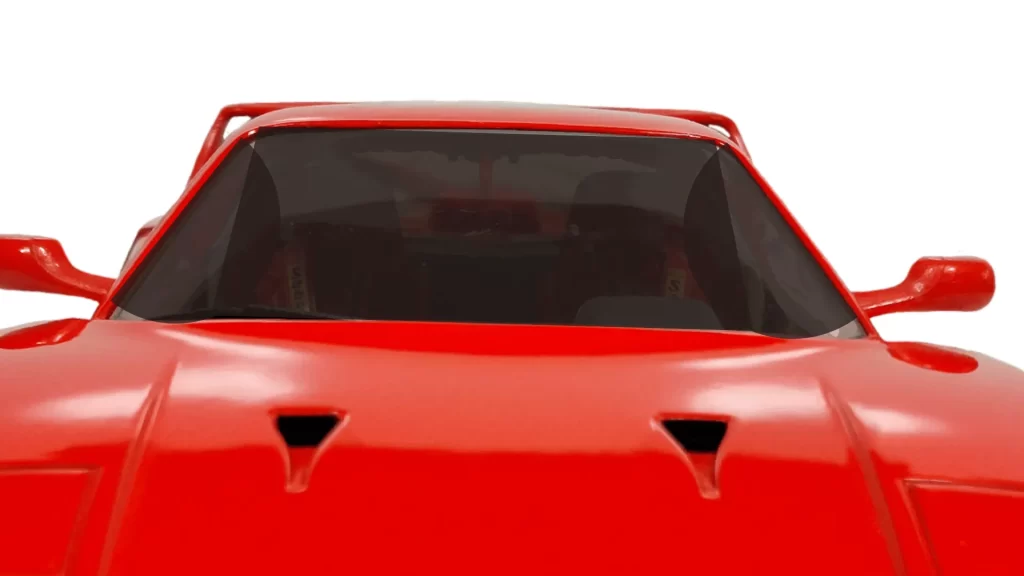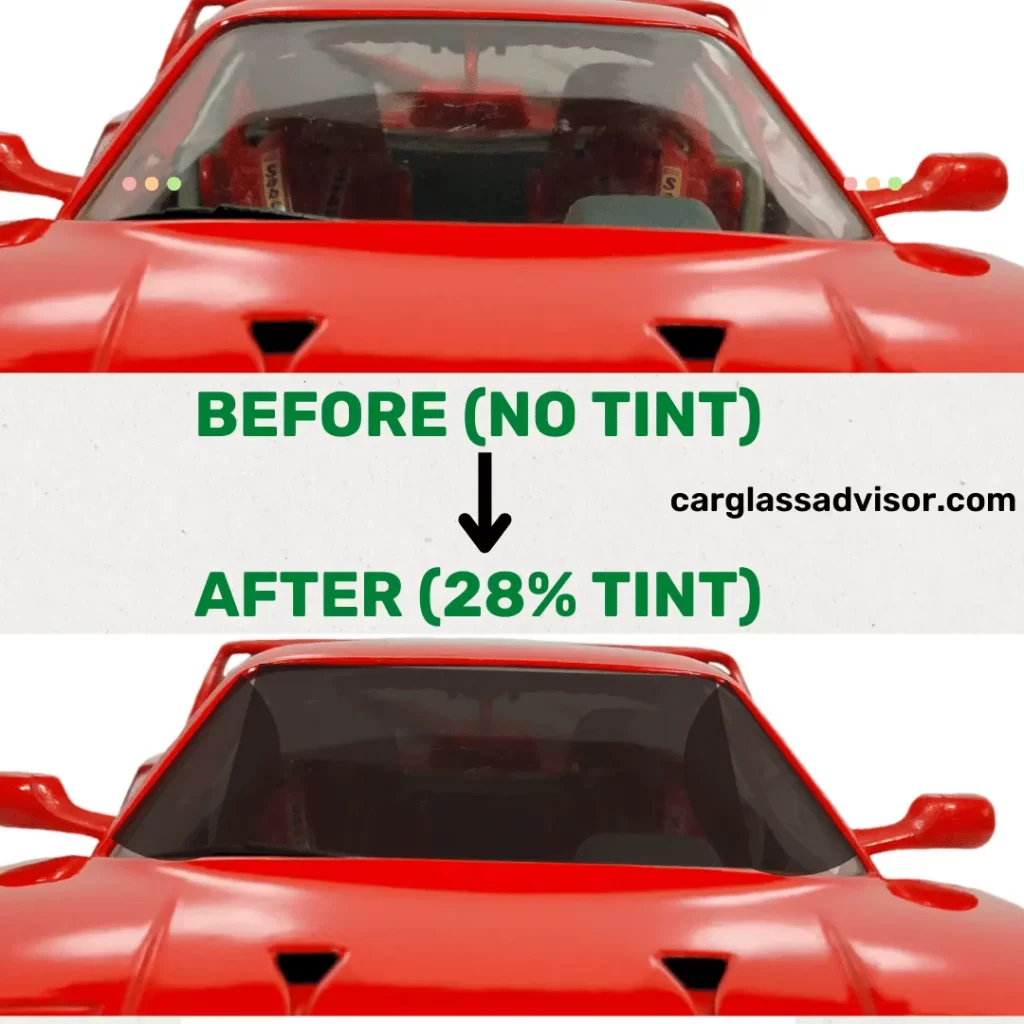Window tinting refers to applying a thin film or coating to the windows of a vehicle in order to reduce the amount of light that passes through. This can be done for a variety of reasons, including to reduce glare, block harmful UV rays, and increase privacy.
When selecting a window tint, one important consideration is the percentage of light that the tint allows to pass through. A 28% window tint means it allows 28% of light to enter the vehicle, while blocking the remaining 72%. We often use this level of tint on the side and rear windows of a vehicle, as it provides a good balance between visibility and privacy.
However, it is important to note that the laws governing the use of window tinting vary by state. In many states, it is illegal to use a 28% window tint or any other level of tint on the front windows of a vehicle. This is because front windows are typically larger and more angled than rear windows, which can make it difficult for the driver to see clearly when they are tinted. The exceptions to this rule are Michigan, Arkansas, Colorado, New Mexico, Washington, Wyoming, South Carolina, Montana, Oklahoma, Mississippi, Florida, and Texas, where the use of window tint on front windows is generally permitted.
Before applying window tint to your vehicle, it is important to check the laws in your state to ensure that you comply. Some states have specific guidelines about the percentage of tint that is allowed on different windows, as well as the type of film that can be used. Failure to adhere to these laws can cause fines and other penalties.
What does 28% tint look like?
A 28% window tint will appear relatively light when viewed from the inside of a vehicle, as it allows a significant amount of light to pass through. From the outside, a 28% tint will appear somewhat darker, but not as dark as a lower percentage tint.
The appearance of a window tint can also vary based on the type of film that is used, as well as the color and intensity of the light outside the vehicle. For example, a 28% tint may appear lighter on a cloudy day than it does on a sunny day, as there is less intense light to block.

A 28% window tint provides a moderate level of privacy and glare reduction, while still allowing the driver to see clearly and maintain good visibility. It is often a good choice for those who want a balance between these benefits and the amount of light that enters the vehicle.
Car Window Tint Percentage Visualization Tool
Select a percentage value from 1 to 100 to see how dark it is:
Selected Percentage:
Use the basic window tint visualization tool above to see how dark 28% tint is. Set the value to 28 and the tool will simulate the tint percentage for the most common black tinting film. However, for other tint colors, use our advanced tint percentage visualization tool. That said, the car picture below shows the comparison between no tint and 28% tint.

Can you see through 28% tint at night?
It is generally possible to see through a 28% window tint at night, although the visibility may be somewhat reduced compared to when the tint is not present. This is because a 28% window tint allows 28% of light to pass through, so there is still some light entering the vehicle. However, the reduced amount of light may make it more difficult to see certain details or colors clearly, particularly if the light outside the vehicle is dim.
It is important to note that the visibility through a window tint can vary based on several factors, including the type of film that is used, the color of the tint, and the intensity of the light outside the vehicle. Some tints may appear darker or more reflective at night, which can further reduce visibility.
It is always important to consider the impact of window tint on visibility when driving, especially at night. If you are concerned about the visibility through a 28% window tint, consider a higher percentage tint or no tint at all to ensure that you have good visibility while driving.
How much does 28% auto window tint cost?
The cost of tinting an auto window 28% tint will vary based on several factors, including the size of the windows being tinted, the type of film used, and the location of the shop or company providing the service. In general, you can expect to pay anywhere from $100 to $400 or more for a 28% window tint, depending on these and other factors.
It is important to shop around and get quotes from multiple companies or shops before deciding on a window tint provider. Be sure to ask about the type of film that will be used, as well as the warranty and maintenance requirements for the tint. This will help you make an informed decision and choose a window tint that meets your needs and budget.
Is 28% tint worth it?
Whether a 28% window tint is worth it will depend on your individual circumstances and priorities. Here are a few things to consider when deciding whether a 28% tint is right for you:
- Glare reduction: A 28% window tint will reduce glare to some extent, but it may not provide as much glare reduction as a lower percentage tint. If glare is a major concern for you, a 28% tint may not be sufficient.
- UV protection: A 28% window tint will block some UV rays, but it may not provide as much protection as a lower percentage tint. If UV protection is a top priority for you, consider a tint with a lower percentage.
- Privacy: A 28% window tint provides a moderate level of privacy, but it may not be as effective at blocking views into the vehicle as a lower percentage tint. If privacy is a major concern for you, consider a darker tint.
- Visibility: A 28% window tint allows a significant amount of light to pass through, so visibility through the tint will generally be good. However, the reduced amount of light may make it more difficult to see certain details or colors clearly, particularly at night.
- Legal issues: Most of the states in the USA don’t permit 27% tint to be used on the front windows, so check out your local laws first.
Ultimately, whether a 28% window tint is worth it will depend on your individual needs and preferences. If you are looking for a balance between glare reduction, UV protection, privacy, and visibility, a 28% tint may be a good choice for you. However, if you have specific concerns or priorities, consider a different percentage of tint or no tint at all.
Conclusion
A window tint with a percentage of 28% allows 28% of light to pass through and blocks 72%. In most states, it is illegal to use this level of tint on the front windows of a vehicle, with the exceptions of Michigan, Arkansas, Colorado, New Mexico, Washington, Wyoming, South Carolina, Montana, Oklahoma, Mississippi, Florida, and Texas. However, it is generally permitted to use this percentage of tint on side and rear windows in many states. It is important to familiarize yourself with your local window tinting laws before applying any tint to your vehicle.

